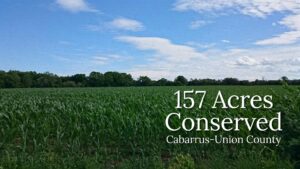
 Dr. Peter Weigl of Wake Forest University gave a presentation at the Friends of Plant Conservation annual meeting at the N.C. Botanical Garden this past week on grassland balds. Grass balds are areas of naturally occurring treeless vegetation dominated by grasses, sedges, and forbs on sites below treeline in predominantly forested regions. You may have seen such balds on areas like Roan Mountain and Carvers Gap. The explanation of their existence has been described by a variety of manmade and environmental factors over the years, but Dr. Weigl suggests that they are “natural and ancient and largely owe their origin and persistence to past climatic extremes and the activities of large mammalian herbivores,” also known as the climate-herbivore hypothesis.
Dr. Peter Weigl of Wake Forest University gave a presentation at the Friends of Plant Conservation annual meeting at the N.C. Botanical Garden this past week on grassland balds. Grass balds are areas of naturally occurring treeless vegetation dominated by grasses, sedges, and forbs on sites below treeline in predominantly forested regions. You may have seen such balds on areas like Roan Mountain and Carvers Gap. The explanation of their existence has been described by a variety of manmade and environmental factors over the years, but Dr. Weigl suggests that they are “natural and ancient and largely owe their origin and persistence to past climatic extremes and the activities of large mammalian herbivores,” also known as the climate-herbivore hypothesis.
The alternative theory is that these balds are isolated artifacts, not natural landscapes, that are a result of Native American activities or agricultural practices of European settlers. Weigl suggests instead that these balds are natural and are a result of climatic changes and the feeding activities of large grazers and browsers over long periods of time, recommending that we should preserve whole bald landscapes and the diverse species found there.
Grasslands, including Piedmont prairies and Coastal plain savannas, are historically known to have existed in the southeast and so grasslands and unforested areas were known from this region. Forested areas on mountain peaks were believed to have been driven down by severely cold climates and were replaced by grasslands or tundra. Native Americans were not thought to use these high peaks for permanent settlement, so their influence there was limited. Certainly European settlers helped maintain balds by grazing livestock, but the balds are known to predate European settlement, and descriptions of balds go back to the 17th century.
Balds are home to a variety of what Weigl calls “rare, endemic, relict and disjunct plant species.” These species are light-dependent and cannot exist in forested habitats. He further states that they must have existed over large enough distances and for long enough periods of time to speciate. These include such species as Gray’s lily and Roan mountain bluets. Balds that grow over have a significant decrease in vertebrate diversity, as well.
Dr. Weigl began his talk by describing an item he had in his hand – a fossilized tooth of a tapir. Tapirs are one of a number of Pleistocene megafauna that once existed, which includes species such as mammoth, mastodon, muskox, bison, elk, and ground sloths. Excavations at Saltville in Virginia resulted in the finding of many of these megaherbivores. In addition, large grazers still play a role in other parts of the world in maintaining grasslands and savannas, like elephants in Africa.
The loss of the North American megafauna came around 11,500 years before present, and early settlers found large populations of elk, bison and deer that had filled that niche on mountain grasslands. In the late 18th century elk and bison were locally extinct, but by the 1830s domestic grazers took their place. Neither are thought to be as effective as the original megafauna.

There are other grassland areas in other parts of the world as well that are similar to the grass balds of the Appalachians. The polonina in Poland are one such habitat that Dr. Weigl has studied. They also support rare plants and have large herbivores including European bison, red deer, wild horses, and wild cattle. In addition to fossil data, there is a record of megafauna left by drawings on the walls of caves in this region. There are also grass balds in the Oregon Coast that have a similar history and rare species.
Though there are other explanations for grass balds, Weigl makes a good case for the climate-herbivory hypothesis. Whatever the origin, it remains that these balds are disappearing as a result of woody plant invasion. Weigl said that in the 1990s the U.S. Forest Service introduced sheep and great pyranese dogs to control the blackberry vegetation, and this resulted in the reappearance of some rare animals. Restoration of these natural bald landscapes is necessary to protect rare biotas, scenic vistas, and historical places, and can be accomplished through herbivores, cutting, mowing and fire. Thinking of these areas as complex landscapes that support rare species indicates the need for management to protect them for generations to come.
*Citation: Peter D. Weigl and Travis W. Knowles. Temperate mountain grasslands: a climate-herbivore hypothesis for origins and persistence. Biological Review (2014).